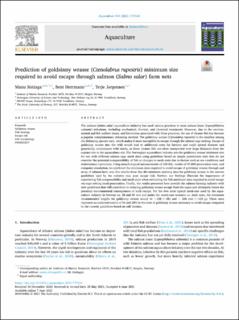| dc.contributor.author | Sistiaga, Manu | |
| dc.contributor.author | Herrmann, Bent | |
| dc.contributor.author | Jørgensen, Terje | |
| dc.date.accessioned | 2021-07-28T12:21:51Z | |
| dc.date.available | 2021-07-28T12:21:51Z | |
| dc.date.created | 2021-06-25T08:44:48Z | |
| dc.date.issued | 2021 | |
| dc.identifier.citation | Aquaculture. 2021, 543, . | en_US |
| dc.identifier.issn | 0044-8486 | |
| dc.identifier.uri | https://hdl.handle.net/11250/2765541 | |
| dc.description.abstract | The salmon (Salmo salar) aquaculture industry has used various practices to treat salmon louse (Lepeophtheirus salmonis) infections, including mechanical, thermal, and chemical treatments. However, due to the environmental and fish welfare issues, and limitations associated with these practices, the use of cleaner fish has become a popular complementary delousing method. The goldsinny wrasse (Ctenolabrus rupestris) is the smallest among the delousing species used, which makes it most susceptible to escape through the salmon cage netting. Escape of goldsinny wrasse into the wild would lead to additional costs for farmers and could spread diseases and genetically contaminate wild stocks, as these cleaner fish are often transported over large distances from the capture site to the aquaculture site. The Norwegian aquaculture industry sets the goldsinny wrasse minimum size for use with different salmon cage mesh sizes using guidelines based on simple penetration tests that do not consider the potential compressibility of fish or changes in mesh state due to factors such as sea conditions and maintenance operations. Using morphological measurements of 100 fish, results of 47,800 penetration tests, and computer simulation, we predicted the minimum sizes required to avoid escape of goldsinny wrasse through and array of salmon farm nets. Our results show that the minimum stocking sizes for goldsinny wrasse in the current guidelines used by the industry may pose escape risk. Further, our findings illustrate the importance of considering fish compressibility and mesh state when estimating the fish minimum sizes required to avoid escape via cage netting mesh penetration. Finally, the results presented here provide the salmon farming industry with new guidelines that will contribute to reducing goldsinny wrasse escape from the cages and ultimately lessen the potential environmental consequences of such escape. For the two most typical mesh-size used by the aquaculture industry in Norway i.e. 30 and 50 mm and under the worst-case scenario i.e. slack state, the minimum recommended lengths for goldsinny wrasse would be ~128 (~28) and ~ 206 mm (~123 g). These sizes represent an underestimation of 16 and 24% in the sizes of goldsinny wrasse necessary to avoid escape compared to the current guidelines based on stiff meshes. | en_US |
| dc.language.iso | eng | en_US |
| dc.publisher | Elsevier Ltd. | en_US |
| dc.rights | Navngivelse 4.0 Internasjonal | * |
| dc.rights.uri | http://creativecommons.org/licenses/by/4.0/deed.no | * |
| dc.title | Prediction of goldsinny wrasse (Ctenolabrus rupestris) minimum size required to avoid escape through salmon (Salmo salar) farm nets | en_US |
| dc.type | Peer reviewed | en_US |
| dc.type | Journal article | en_US |
| dc.description.version | publishedVersion | en_US |
| dc.source.pagenumber | 10 | en_US |
| dc.source.volume | 543 | en_US |
| dc.source.journal | Aquaculture | en_US |
| dc.identifier.doi | 10.1016/j.aquaculture.2021.737024 | |
| dc.identifier.cristin | 1918362 | |
| dc.description.localcode | This is an open access article distributed under the terms of the Creative Commons CC-BY license, which permits unrestricted use, distribution, and reproduction in any medium, provided the original work is properly cited. | en_US |
| dc.source.articlenumber | 737024 | en_US |
| cristin.ispublished | true | |
| cristin.fulltext | original | |
| cristin.qualitycode | 2 | |

